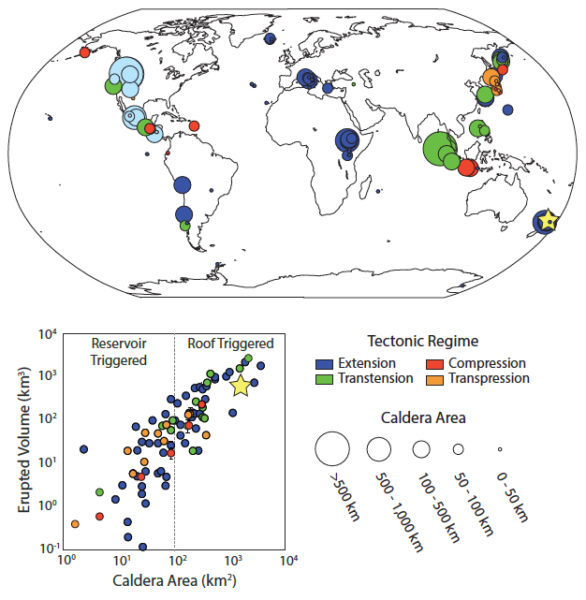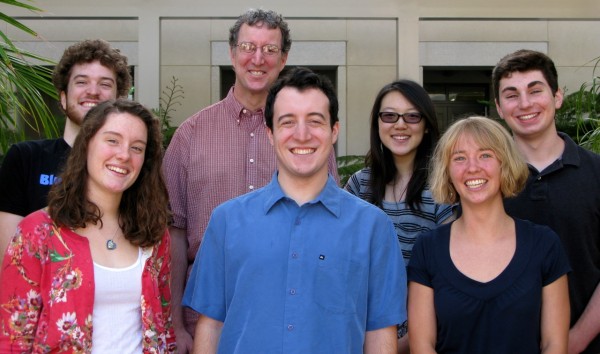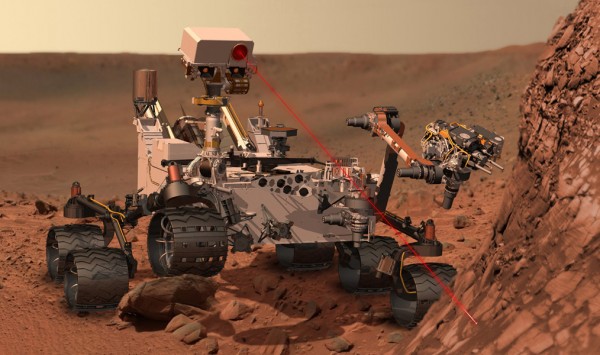Quite often when I work with students I learn at least as much as they do. That was definitely the case when collaborating with Haley Cabaniss and her advisor Dr. Patricia Gregg (UIUC) on the project “The Role of Tectonic Stress in Triggering Large Silicic Caldera Eruptions,” recently published in Geophysical Research Letters.

As you can observe in the figure above, most large calderas (area > 100 km^2) form in regions characterized by tectonic extension or transtension, whereas calderas forming in regions of compression or transgression tend to be smaller in size. Using temperature-dependent viscoelastic numerical models we assessed the 3D mechanical stability of large magma reservoirs as new molten material is added to them over time, and demonstrated three key things: (1) magma reservoirs fail (forming calderas) most readily and/or at the lowest magma flux rates when located in tectonic regimes characterized by extension; (2) compressive tectonic regimes can stabilize reservoirs initially, but eventually assist destabilization (relative to models without any regional tectonic stresses) due to strain accumulation; and, (3) even very large magma reservoirs will remain mechanically stable for only 100’s-1000’s of years during a magmatic fluxing event, a time frame which is geologically quite rapid yet likely to provide ample warning of a pending eruption on human time scales. This suite of results advances our insight into large magma reservoirs significantly, and to first order matches observations at persistently active systems like Taupo in New Zealand, thus aiding efforts to better understand one of the most hazardous of geological phenomena–a caldera-forming ‘supereruption.’
Reflecting this excitement, it was fun to see the resulted shared in venues like Newsweek and Forbes!
For more information see: UIUC Press Release and original article in GRL.
Posted in Uncategorized | Comments (0)

— Student research team, Summer 2014
In March volcanology research results, obtained by six students working with Prof. Grosfils during the previous summer, were presented at the 2015 Lunar and Planetary Science Conference in Houston, TX. Work performed by Robby Goldman (’15) and Jack Albright (’16) was shared via “Ring Fault and Caldera Formation: Insights Provided by Three-Dimensional Elastic Finite Element Models,” while Erin Barry (’17), Annika Deurlington (’16), Amanda Yin (’17) and Michael Wucher (’17) helped advance our understanding of subsurface magmatism via the presentation “Using Map-Derived Hoop Strain and Elastic Models of Reservoir Formation to Quantify the Degree of Dike Emplacement at Giant Radial Lineament Systems on Venus.” Our tradition of celebrating student achievement and performance at the conference continued, with attending students joining other Sagehen alumni at the conference for some conversation and reminiscing over refreshments: while planetary geology is a specialized field to be sure, it is a lot of fun to see the cadre of Sagehen enthusiasts involved growing steadily over time!
Posted in Uncategorized | Comments (0)
At approximately 10:31 PM PST, August 5th 2012, the dune buggy-sized Curiosity rover touched down gently onto the surface of Mars, culminating a series of amazing engineering achievements. Once tests of the rover’s systems are completed Curiosity will begin its traverse toward the kilometers tall central peak mound within Gale crater, searching within the strata for new insights into the complex climatic development of the red planet and assessing the astrobiological implications.
Follow the science action over the coming months at http://mars.jpl.nasa.gov/msl/
To see an amazing rotatable 360 panorama of the landing site (view from the rover), including some awesome layering, click here.

— rover at work (image credit: NASA/JPL)
Posted in Uncategorized | Comments (0)


